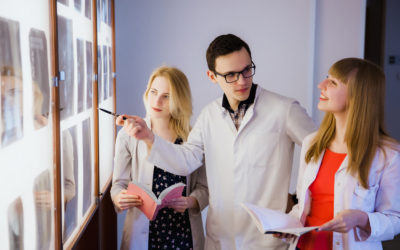You have a cut that looks infected or a sore throat that will not go away, and your first instinct may be to see a medical doctor for an antibiotic. And in many situations that is precisely the thing to do, especially for children, diabetics, the elderly and people taking medicines that suppress the immune system. However, a growing number of Americans concerned about developing antibiotic resistance are making their first calls to an alternative medicine practitioner such as a naturopathic or chiropractic physician.
Complementary and alternative medicine (CAM) or “integrative” practitioners approach diagnosing, treating, and preventing illnesses and infections in a way that promotes natural healing. While antibiotics are still necessary in some cases, and some alternative medicine practitioners may be able to prescribe them or will refer patients to their allopathic physicians, they are trained to recommend appropriate natural treatments and preventive approaches that can save the use of heavy-hitting prescription antibiotics for more serious conditions, and reduce the prevalence of antibiotic-resistant bacteria.
This is one reason that naturopathic and chiropractic students at National University of Heath Sciences spend hundreds of hours studying the nature of infectious diseases, the immune system, and the mechanisms of natural products and foods.
Why Should We Be Concerned About Antibiotic Resistance?
According to the World Health Organization (WHO), bacterial resistance to antibiotics is one of the most significant threats to health, food security and development around the world. When bacteria become so resistant that antibiotics can no longer kill them, they multiply uncontrollably and become known as “superbugs.” This is a significant concern because, according to the U.S. Centers for Disease Control and Prevention (CDC), “In some cases, the antibiotic-resistant infections can lead to serious disability or even death.”
One of the biggest issues with antibiotic use is that they frequently have collateral effects on beneficial bacteria that keep us healthy. Rather than solely targeting the pathogenic bacteria causing the illness, antibiotics take a “shotgun” approach by affecting both “good” and “bad” bacteria. This means that when you take an antibiotic drug such as amoxicillin, it not only kills the bad bacteria in your gut, but the good bacteria as well. This rearrangement of the entire microbiome of the gut, which is a very complex ecosystem, is problematic. A constant pipeline of research is uncovering the ways that our microbiome and our body are linked, and microbiome influences on cancer, aging, heart health, mood and more are emerging.
How Did Bacteria Get So Antibiotic Resistant?
Antibiotics, in one form or another, have been used by civilizations for millennia, according to research by the Microbiology Society. Although people hundreds or thousands of years ago did not necessarily understand that bacteria were the cause of some infections, they used natural products such as tree balsams, plant extracts and lichens to treat infections. Our ancestors were also very skilled at creating fermented foods and drinks that reinforced a healthy microbiome, ranging from yogurts to Asian fermented foods like miso and tempeh.
With the introduction of modern antimicrobial drugs such as penicillin (used to treat staphylococcus, or staph infections, for example) in the 1900s, conventional medical doctors started using them to fight bacterial infections in both animals and humans. These have indisputably lead to many lives saved and will continue to be extremely important medicines. However, as time has gone on, some infections and diseases have become resistant to the use of antibiotics.
While some antibiotic resistance occurs naturally over time as bacteria change, the widespread overuse of antibiotic drugs rapidly accelerates this process. The growing antibiotic resistance crisis boils down to an issue of human behavior:
- Physicians overprescribe antibiotics to patients
- Patients demand antibiotics from physicians when they are unnecessary for treatment, such as for sore throats caused by viral infections
- Patients take antibiotics too frequently, don’t take them as directed, or don’t fully complete their antibiotic regimen
- Agriculture workers use antibiotics on healthy animals for growth promotion and to prevent disease, which are absorbed by humans in their daily diets
This is where the advantages of alternative medicine come into play for medical practitioners facing a rapidly growing antibiotic-resistant bacteria global crisis. Although there are many useful home remedies, a fully trained doctor of naturopathic medicine or chiropractic medicine from an accredited university such as NUHS can ensure proper treatment.
How Alternative Medicine Practitioners Help
One of the advantages of alternative medicine for treating bacterial infections is that it provides non-antibiotic natural treatments that avoid damage to the good bacteria we need for optimal health.
For example, honey, viewed in ancient times as medicine, is a natural antimicrobial substance that contains bacteria-killing factors (high sugar content, low acidity, low water content) and chemicals such as hydrogen peroxide and phytochemicals. A recent article in the Journal of Microbiology, Immunology and Infection indicates that honey has solid evidence behind it for use in skin infections. Further quality research studies will help clarify in which situations honey can work best.
Among other options is strengthening the immune system through nutrition or a carefully chosen plan for plant extracts that temporarily “change the terrain” so that infection is less likely. Some plant extracts make it harder for bacteria to colonize the throat, stomach, bladder or skin. Students at NUHS learn about dozens of plants that yield compounds that inhibit the growth of bacteria. While these do not always work in precisely the same way as an isolated antibiotic drug, they can be useful for many situations.
Clearly, the years of training that go into the making of a naturopathic physician or chiropractic physician are an important foundation in making clinical decisions about what infections can be treated naturally and what need a synthetic drug approach. In some states, CAM doctors can prescribe these substances, but in all scenarios they are taught when to recognize that the best thing for the patient is an antibiotic. With less habitual use of antibiotics and stronger immune systems, we can help slow down the phenomena of antibiotic resistance.
You Can Be Part of the Future of Natural Medicine
National University of Health Sciences (NUHS) is on the leading edge of the future of complementary and alternative medicine, training and supporting the next generation of holistic healers.
To learn about the advantages of a career in alternative medicine and what you can expect from National University’s accredited educational programs, check out our Career Guide to Becoming a Naturopathic Doctor.
{{cta(’94c66fe0-f8c5-4984-a1aa-ec2983da50f6′)}}




0 Comments